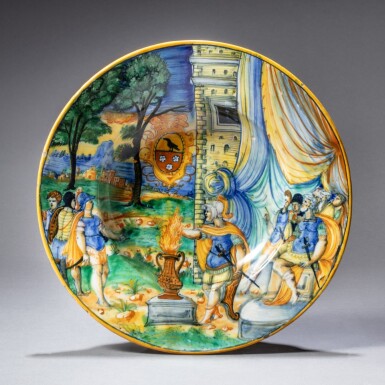
Probably Picchi Workshop, attributed to Andrea da Negroponte, Italian, Castel Durante, circa 1550-1570
An armorial plate with Mucios Scaevola
No reserve
Estimate
6,000 - 8,000 EUR
We may charge or debit your saved payment method subject to the terms set out in our Conditions of Business for Buyers.
Read more.Lot Details
Description
inscribed on the reverse “mutio che la sua destra erante cocie” (Mucios burning his erring right hand)
Tin-glaze earthenware
25.47cm. diameter, 10in.
Locknerm Wurzburg (1990s);
Dr. Hans Reimer Collection, Hamburg;
Rainer Zeitz Ltd., London, 2010;
Where acquired.
The inscription on this plate representing the story of Mucius Scaevola, was taken from Petrarch’s The Triumph of Fame, which includes Mucius Scaevola as a symbol of courage and patriotic virtue. According to Roman legend, Scaevola attempted to kill the enemy King Porsenna but was captured. To show Roman bravery, he placed his hand in the fire in front of the enemy, earning lasting fame.
This plate is part of a large undated, armorial service with unidentified arms. It is closely related stylistically to a group of pieces characterised by the same quick brushstrokes and mannerist painting style as the crespina on the Museum of Arezzo (Fuchs op.cit., 1993, no. 217) signed andrea da negroponte and the surviving jars of the Boerio pharmacy set, some of them marked as made in the workshop of M° Ludovico Pichio in Castel Durante and bearing the dates 1562 and 1563.
Three other plates from this armorial set are known: The Gathering of Manna, Walters Art Gallery, Baltimore, (inv. 48.1514, Wilson, op. cit., fig. a, p.300); Sinon before Priam, Louvre Museum, Paris (inv. OA 1592, ibidem, fig. b, p.300); The Sacrifice of Marcus Curtius, now in the collection of the Fondation Gandur, Geneva (inv. FGA-AD-OBJ-0067).
The same arms occur on a salt, perhaps made in Urbino rather than Castel Durante, in the Hermitage Museum, St. Petersburg; E. Ivanova, op. cit., no.147.
LODOVICO AND ANGELO PICCHI WORKSHOP
Lodovico (d.1573) and Angelo (d.1582 or 1583) Picchi’s workshop was one of the most productive in Castel Durante. Their business was flourishing by 1548-1550 when they received a major commission for pharmacy jars from a Palermo-based Genoese merchant Nicola Canizia. In 1562 the brothers received another order from Palermo, this time from a merchant named Andrea Boerio (of this latter service one jar dated 1562, two others 1563, and two marked as made in the workshop of M° Ludovico Pichio in Castel Durante are known, as well as numerous unmarked jars with the same arms). The Boerio commission proved to be fateful for the Picchi brothers; they were taken to court for failing to deliver the service in time, forcing them into financial trouble. They moved to Rome and formed partnerships with various fellow Durantine painters.
ANDREA DA NEGROPONTE
The pottery-painter identified by Johanna Lessmann as Andrea da Negroponte was the most prolific painters of istoriato wares in Castel Durante in the 1550s and 1560s. He can be tentatively considered the main painter of the Boerio series of jars (1562, 1563) and was probably active principally in the workshop of the Picchi brothers. His work is characterised by a mannerist quality and shows a quick use of the brush for an impressionistic effect.
There is a mould-made bowl in the Museum of Arezzo (Fuchs, op. cit., 1993, no.217) that appears to be by the same hand, which bears the name andrea da negroponte.
Although the name of Andrea da Negroponte has not been found in Castel Durante documents, John Mallet suggests, following Lessmann, the idea that Andrea da Negroponte was a painter rather than an intended client or a collector, a retailer or a workshop owner. This is reinforced by the existence of a plate in the Barilla sale (Sotheby’s London, 24 March 2012, lot 16) painted with the The Sacrifice of Marcus Curtius and marked on the reverse “A.B.”, which may be the initials of the painter called Andrea, a surname or a nickname. Da Negroponte, meaning in Italian From the Greek island of Euboea,” may be the name of a painter who immigrated from Greece.
RELATED LITERATURE
T. Wilson, The Golden Age of Italian Maiolica Painting. Catalogue of a private collection, Torino 2018, pp.342-343;
J. Lessmann, Italienische Majolika, Katalog der Sammlung, Brunswick, 1979, p.148.
C. D. Fuchs, Maioliche istoriate rinascimentali del Museo Statale d'Arte Medioevale e Moderna di Arezzo, Arezzo, 1993, no. 217, p. 233;
J. Lessmann, Italienische Majolika, Katalog der Sammlung, Brunswick, 1979, p.148;
E. Ivanova, Mayolika Urbino XVI-XVII bekov. Katalog kollektsiy, Urbino Maiolica Sixteenth-Seventeenth century. Catalogue of the collection, St. Petersburg. State Hermitage Museum, 2019, no.147.
You May Also Like










